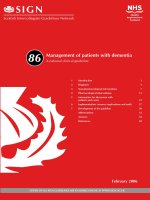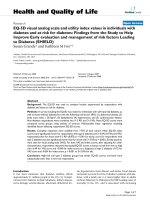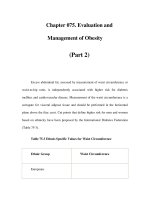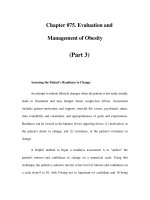Evaluation and Management of Delirium and Dementia
Bạn đang xem bản rút gọn của tài liệu. Xem và tải ngay bản đầy đủ của tài liệu tại đây (1005.25 KB, 68 trang )
Evaluation and Management of Delirium
and Dementia
Dr.M.Ashfaq Burney
1
Outline
• Definitions
• Epidemiology
• Delirium assessment, diagnosis, management
• Dementia assessment, diagnosis and
management
2
Objectives
• To be able to identify patients suffering from
delirium.
• To be able to identify patients having
dementia.
• Each of the group management and referral
criteria.
3
• What are normal memory lapses?
Memory in daily task: Unexplained
Memory
in daily
task:Forgetting
confusion
in familiar
places an
acquaintance
Performance
of familiar name.
task: Forgetting
Performance
tasks:Leaving
food to burn
to serveofmeal
after preparing
Language:Trouble
finding
the words
right word
Language: Forgetting
simple
or
Orientation:Forgetting
the day or date
appropriate words
Judgment:Choosing
to wear
a light
sweater
Orientation: Getting
lost
in own
on a cold night
neighborhood
Abstract thinking:Making
a mistake
in
Judgment:
Wearing two blouses
at one
balancingtime
cheque book
Temporarily
misplacing
car keys
or basic
glasses
Abstract thinking:
Inability
to do
Gradual perceptible
change in personality
calculation
and Putting
mood iron in freezer
Misplacing objects:
Initiative:Occassional
tiredness
and wrist watch
in bowlfrom doing
house work Severe
and social
obligation.
Personality:
Moods
swings
Initiative: Sustained lack of interest.
Alzheimer asscociation, what are warning signs?sept.1998
Alzheimer association, what are warning signs?sept.1998
4
CASE
• Dr. X was a 74-year-old retired professor, recently diagnosed with
Alzheimer's disease. He had been started a trial of acetyl cholinesterase
inhibitor and had shown a promising early response. An elective
orthopedic procedure was planned. Care was taken to optimize his
medical status ahead of time. The operation proceeded uneventfully and
eighteen hours postoperatively he was doing very well. He was discharged
home in stable condition. In the early hours of the morning following
discharge, he suddenly became confused and called out. He was taken to
the near by clinic, where he was given 5 mg of haloperidol and sent home.
In the view of the family who were caring for him the drug was found
ineffective, as his confusion and agitation worsened. So he was taken to
your clinic the same day in night.
Examination showed an extremely agitated, restless man in considerable
psychological distress. He was in physical restraint, not recognizing his
wife.
• What's going on?
• What would be your response?
6
• Dr. X was a 74-year-old retired professor, recently diagnosed with
Alzheimer's disease. He had been started in an open-label trial of acetyl
cholinesterase inhibitor and had shown a promising early response. An
DeliriumCare was taken to optimize
elective orthopedic procedure was planned.
Refer
his medical status ahead of time. The operation
proceeded uneventfully
CAM
and eighteen hours postoperatively heDo
was
doing very well. He was
discharged home in stable condition. Do
In MMSE
the early hours of the morning
following discharge, he suddenly
became
confused and called out. He
Stop
all the medication
was taken to the near by clinic,
where he
was given done
5 mg of haloperidol.
Get medical
investigations
In the view of the family who were caring for him the drug was found
ineffective, as his confusion and agitation worsened. So he was taken to
your clinic the same day in night.
Examination showed an extremely agitated, restless man in considerable
psychologic distress. He was in physical restraint and not recognizing his
Hyponatermia
was found to be the cause.
Foot Note
wife.
•
•
Later was discharged.
Other
than
difficulty
with stairs and
the bathtub,
he was
He had continued
to be
treated
symptomatically
without
addressing
the
What'sunderlying
going on?causes ofindependently
mobile
nowith
assistance
in
delirium, he may
well and
haverequired
ended up
a permanently
What would beworsened
your response?
of medical
daily living.
cognitive statusactivities
and more
complications.
7
Definition of Delirium
(Acute Confusional State)
Delirium is characterized by
• Disturbance of consciousness
• Change in cognition that develops over a short period of time.
The disorder has a tendency to fluctuate during the course of
the day.
There is evidence from the history, examination or
investigations that delirium is a direct consequence of a
general medical condition, drug withdrawal or intoxication.
8
Cognitive Impairment
• Is a broad term to describe a wide variety of impaired
brain function relating to the ability of a person to:
• Think
clinical syndrome with deficits in
• Concentrate
memory or other cognitive
abilities that have minimal impact
• React to emotions
on day-to-day functioning and
• Formulate ideas
does not meet criteria for
dementia
• Problem solve
• Reason
• Remember
9
Differential diagnosis of Cognitive
Alzheimer’s disease
Impairment
•
•
•
•
•
•
•
1. Neurodegenerative
2. Metabolic / Deficiency
3. Vascular (e.g. Stroke)
4. Infectious
5. Structural
6. Epileptiform
Other
Diffuse lewy body disease
Dementia of Parkinson's disease
Progressive supra-nuclear palsy
Fronto-temporal dementia
Vitamin B12 deficiency
Thyroid disease
Alcohol related
Neurosyphilis
HIV related
Herpes simplex encephalitis
Creutzfeldt Jacob disease
Brain tumor and NPH
Complex epilepticus
Depression, delirium, trauma,
metal toxicity, MS 10
Delirium is common among
Delirium Stats
older adults in acute care
settings (prevalence
Overall prevalence of delirium in the community
is only 1 to 2
estimates
typically
percent, the prevalence increases with age, rising to 14range
from 10–60%).
percent among those more than 85 years old.
Delirium at admission: 14-24%, during hospital stay 6% to
65%, post operatively 15% to 53%.
54% Delirious Elderly Patients NOT Recognized By Physicians
And Nurses.
60% of patients in nursing homes or post acute care setting.
The one-year mortality rate associated with cases of delirium
is 35 to 40%.
11
8 SIGNS OF DELIRIUM
•
•
•
•
•
•
•
•
Disordered thinking
Causes of delirium
Euphoria, fearful, depressed, angry
D- DRUGS
Language impaired
E-ENDOCRINE
Illusion , delusion, hallucinations
L-LOW OXYGEN
Reversal of sleep awake
cycle
I-INFECTION
R-URINARY RETENTION
Inattention
I-INFLAMMATORY REACTION,INTOXICATION
Unaware / disoriented
U- UNDERPERFUSED CHF, STROKE
M-METABOLIC
Memory deficits
12
Risk factors
•
•
•
•
•
•
•
•
•
•
•
Risk factors
Age older than 65 years
Dehydration
Dementia
Functional dependence
or immobility
Infection at hospital
admission
Malnutrition
Multiple co morbidities
Multiple medications
Chronic renal or hepatic
impairment
Severe illness, admission
to intensive care unit
Vision or hearing impairment
Precipitants
Electrolyte abnormalities
Environmental factors (e.g.,
excessive noise, interrupted
sleep, unnecessary stimuli)
Hypoxia, hypoglycemia, or
ischemia
Medications (especially
Anti-cholinergics, narcotics,
and sedative-hypnotics)
Neurological disorder
(e.g., stroke, seizures)
Pain
Sleep deprivation
Surgery
Urinary catheter
Withdrawal from alcohol, illicit
drugs, or benzodiazepines
14
Selected Medications That May Precipitate Delirium
•
•
•
•
Anticonvulsants
Barbiturates
Anti-parkinsonian agents
Benztropine, trihexyphenidyl
Antipsychotics
Tricyclic antidepressants, Lithium,
Sedatives
Benzodiazepines
• Histamine H2 blockers
Cimetidine, Ranitidine
• Anti nauseants Scopolamine, Dimenhydrinate
• Antihistamines HI Blocker Hydroxyzine
• Cardiac medications
• Antibiotics
Antiarrhythmics B-blockers, Methyldopa
Fluoroquinolones
15
HISTORY
•
•
Wherever possible
corroboration
should be sought
Onset and course of confusion
from the care giver,
Previous intellectual functions (e.g. ability to manage household
affairs, pay
or any source with
bills, compliance with medication, use of telephone and transport)
good knowledge of
Co morbid illness
the patient
•
• Full drug history including non-prescribed drugs and recent drug cessation
Activity of daily living (ADL):
(especially Benzodiazepines)
DEATH
• Alcohol history
Dress
• Previous episodes of acute or chronic confusion
Eat
Ambulate
• Functional status (e.g. activities of daily living)
Toilet
• History of diet and food intake
Hygiene
• History of bladder and bowel voiding
- Instrumental ADL (IADL):
SHAFT
• Aids used (e.g. hearing aid, glasses etc)
Shop
• Social circumstances and care taker detail
Housekeep
Account
Personality, mood and behavior changes
Food prepare
Details from the care giver should also be taken
Transportation
16
PAGE LAY OUT
•
•
•
•
Age
Co morbids
Presenting complaints
Drugs details
E= EAR
E= EYE
B=BLADDER
B=BOWEL
F=FOOD
W-WEIGHT
M-MOOD
M-MOBILITY
M-MEMORY
HEAD TO TOE
EXAMINATION,
INCLUDING
SYSTEMS.
CAM/MMSE/
MINICOG
ADL: DEATH
IADL:SHAFT
17
Physical Examination
•
•
•
•
•
•
Vitals
General Exams
Systemic Exam
Conscious level
Nutritional status
Evidence of pyrexia
Search for infection: lungs, urine, abdomen, skin
Evidence of alcohol abuse or withdrawal (e.g. tremor)
Cognitive function using a standardized screening tool, e.g.
AMT (ABBREVIATED MENTAL TEST) or MMSE.
• Neurological examination (including assessment of speech).
• Rectal examination – if impaction is suspected
18
THE ABBREVIATED MENTAL TEST(AMT)
(1)
(2)
(3)
(4)
What is your present age (+ - 1 year)?
BMJ 2011;343:d5042
doi: 10.1136/bmj.d5042
•
___________
The six item cognitive impairment test
What is the time just nowSix
(+ -questions
1 hour)?
___________
1. What year is it? (correct:0 incorrect:4)
What year is it?
___________
2.What month is it?(correct:0 incorrect:3)
3.Give the patient an address phrase to ___________
remember with five
What is the name of this place?
components (such as John Smith, 42 High Street,Bedford)
4.About what time is it (within one hour)
Please memorise the following address correct:0,incorrect:3)
42 West Street
5.Count backwards from 20-1(correct:0, 1 error:2, >1
What is your birthday (date
and month)?
__________
error:
4)
6.Say the months of the year in reverse repetition.
Whats the independence day date?
___________
Same as above)
What is the President's name?
3.Ask the patient to repeat the
___________
address phrase
requested earlier. Correct:0, 1 error: 2, 2 error:4, 3 errors: 6, 4
Can you recognise doctor/nurse/son/daughter..............................two people? ___________
errors: 8; all incorrect: 10.
(5)
(6)
(7)
(8)
(9) Please count from 20 backwards to 1
___________
0-7= not significant. 8-9: probable significant , 10-28: significant.
Handbook
of Ifamily
Medicine 3rd edition.
(10) Can you remember the address
which
gave you?
___________
A score of ≤7 out of a possible 10 suggests cognitive impairment.
19
Cut off 23/24 out of 30.
Mild:> 20
Moderate: 10-19
Severe:<10
20
Delirium Diagnostic Criteria
(CAM)
1.
Acute Onset and Fluctuating Course
2. Inattention
Is there Acute change in
cognition from baseline?
Abnormal behavior
fluctuates during the day:
comes and goes, increases or
decreases
3. Disorganized thinking
4. Altered Level ofHyperactive
consciousness
delirium:
Easily distractible or losing
tract what
was being said.
is characterized
by increased
motor activity with agitation, hallucinations and
inappropriate behavior.
CAM (Confusion Assessment
Method)
requires
presenceisRambling
of
featuresor1irrelevant
andby2
Mental
status
anything
Hypoactive
delirium
inthecontrast
characterized
and either 3 or 4.
i.e.and lethargy
reducedbeside
motoralert;
activity
and has a poorer
conversation,
unlcear or
hyperalert, drowsy,
prognosis.
switching from subject to
stuporous, comatose
subject
21
INVESTIGATIONS
•
•
•
•
•
•
•
•
•
Pulse oximetry
Urinalysis
Glucose
Full blood count including C reactive protein
Urea and electrolytes, calcium, B12 and folate level
LFTs
Blood cultures
Chest X-ray
ECG
22









